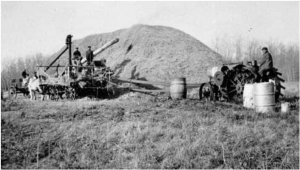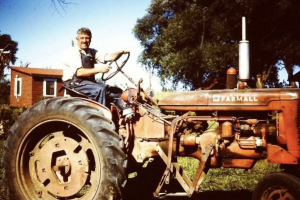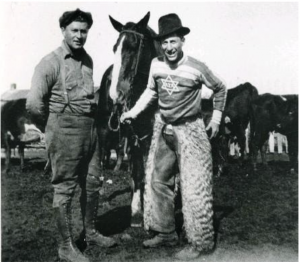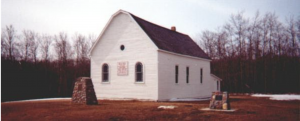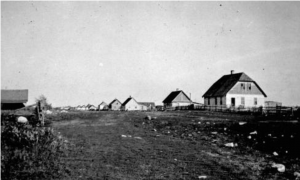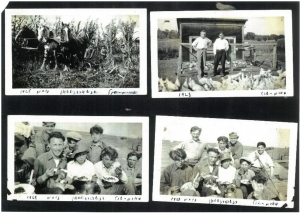Canada
Jewish farming in Canada occurred mostly in parallel to developments in the United States starting in the late 1800s but on a smaller scale. Early Jewish pioneers in Saskatchewan, Manitoba, Alberta and Quebec provinces who were drawn to the land by national homesteading policies encountered stark challenges unique to the northern expanses in Canada, including extreme winters, brutal droughts and severe lack of transportation infrastructure. The first generation of colonies were founded spontaneously in the 1880s in Saskatchewan:
-
Moosomin, also called “Jew Jerusalem, in 1884.
-
Wapella, 1886.
-
Oxbow-Hirsch, 1886

John Lehr, Doomed to Failure: The Jewish Farm Colony of Hirsch, Saskatchewan, Manitoba History 89 (2019).
Much like developments across the border in the U.S., colonies in Canada depended on support and expertise from philanthropic organizations, particularly Baron de Hirsch’s Jewish Colonization Association in cooperation with the Jewish Agricultural and Industrial Aid Society of New York. Together, the JCA and JAS established a total of ten colonies in Western Canada and Northern Quebec at the start of the 20th century:
Saskatchewan: These colonies grew mostly grains, making them very vulnerable to environmental conditions.
-
Qu’Appelle, constituted by the Lipton (1901) and Cupar (1904) colonies
-
Edenbridge (1906)
-
New Herman, later known as Sonnenfeld and Hoffer (1906), considered one of the more successful colonies in Canada. Most of the pioneering settlers had graduated before emigration to Canada from the Jewish Colonization Society’s 400-acre Baron de Hirsch Agricultural School at Słobódka-Leśna in eastern Galicia, Poland.
Jewish colonists threshing wheat, near Lipton
Credit: Canadian National Archives
Manitoba: Colonists in this province mostly cultivated vegetables
Bender Hamlet, also called Narcisse (1903)
Quebec: Colonists here mainly raised dairy herds, providing them with steady, relatively dependable income.
-
La Macaza (1904)
-
New Glasgow (1904)
-
Sainte Sophie (1904)
Willie Rudy, a third-generation Jewish farmer born in New Glasgow, manager of the local hotel and served two terms as mayor of Sainte Sophie in the 1960s.
Credit: Jewish Farmers of Ste. Sophie, New Glasgow & St. Lin
Alberta: These colonies had mixed grain, vegetable and livestock farms, helping to stabilize their household economies.
-
Rumsey (1906)
-
Trochu (1906). Trochu was the largest of the Jewish settlements in Canada, with 89 families, totaling 238 people, and 19,520 acres.
Sam Raskin, left, with Curly Gurevitch, the “Jewish Cowboy” from the Rumsey-Trochu colonies, 1930
Credit: “Exhibit Celebrates Jewish Canadians,” Calgary Herald, July 8, 2017
By 1906 there were hundreds of settlers in the Canadian colonies. Their relative success brought the Jewish Colonization Society to resettle thousands more refugees fleeing pogroms in Russia. This partial list of new colonies reflects the sense of urgency at the time in the Society:
Manitoba:
-
Pine Ridge (1907)
-
Bid’s Hill (1911)
-
Camper, also called New Hirsch (1911). Some of its members had emigrated to Canada from the Israelovka Colony in southern Ukraine.
Saskatchewan:
-
Eyre (1910)
-
Montefiore, also called Alsask (1911). Some of Montefiore colonists had already previously acquired homesteads in North Dakota.
-
Rosetown (1911)
Beth Israel Synagogue, Edenbridge Colony. The plaque adjoining the building states that colonists built the synagogue in 1908. In the early 1920s Edenbridge was home to 50 families but declined in later decades.
Credit: https://web.ncf.ca/lavitt/jewishfarmcolonies/edenbridge/edenbrdg.html
By 1914 the Canadian branches of the Jewish Colonization Society and the Jewish Agricultural Society had helped to settle approximately 1000 people on 250 family farms totaling about 50,000 acres, of which more than 15,000 were already cultivated. This pace accelerated during the First World War due to growing national demand for farm produce.
Colonists’ homes, Narcisse Colony, Bender Hamlet, Manitoba 1921
Founded in 1903 and named after its founder, Jacob Bender. Abandoned in 1927 due to poor soil, environmental challenges and plummeting commodity prices
Credit: Wikiwand
Postwar recession caused prices for agricultural goods to plunge, bringing economic ruin to many Canadian colonists during the first half of the 1920s; four of the smaller settlements – Eyre, Montefiore, Narcisse and New Hirsch – disappeared entirely, while most others saw communities shrink.
Morris Saxe, an immigrant from Odessa trained in agriculture and a strong advocate of Jews returning to the land, opened the Canadian Jewish Farm School in 1927 on his farm in Georgetown, Ontario. Evidently, Saxe modeled the School on Woodbine and Peekskill. [link to Philanthropy page]. He intended to train young Jewish immigrants fleeing hyper-nationalist Poland. The School’s promise to prepare them as future farmers enabled the boys to secure entrance visas into Canada.

Credit: Canadian Jewish Archives, Montreal
Having hosted 79 refugee teenagers starting in 1928, Saxe’s Farm School was short-lived. It closed in 1930 due to lack of funds and under a cloud of mistrust with its main funder in Detroit.
